Cells, tissues and organs -> bone
Bone: Structure and Function
Bones are an essential part of the human body, providing structure, support, and protection for various organs and tissues. They also play a crucial role in the production of blood cells and the storage of minerals such as calcium and phosphorus.
Structure of Bone
Bones are composed of two main types of tissue: cortical bone (compact bone) and trabecular bone (spongy bone). Cortical bone is dense and forms the outer layer of bones, providing strength and protection. Trabecular bone, found at the ends of long bones and within flat bones, has a spongy appearance and is responsible for supporting the bone's structure and facilitating the exchange of nutrients and waste products.
Microscopic Structure
At a microscopic level, bone tissue consists of osteocytes (bone cells) embedded within a matrix of collagen fibers and mineral salts, primarily calcium and phosphorus. This unique composition gives bone its strength and resilience.
Functions of Bone
- Support: Bones provide a framework for the body, allowing us to stand, move, and maintain posture.
- Protection: Bones protect vital organs such as the brain, heart, and lungs from injury and trauma.
- Movement: Muscles attach to bones via tendons, allowing for movement and locomotion.
- Mineral Storage: Bones store minerals, particularly calcium and phosphorus, which are essential for various physiological processes.
- Blood Cell Production: Within the bone marrow, blood cells, including red blood cells, white blood cells, and platelets, are produced.
Common Bone Disorders
Several disorders can affect the skeletal system, including:
- Osteoporosis: A condition characterized by reduced bone density and increased susceptibility to fractures.
- Osteoarthritis: Degenerative joint disease that affects the cartilage within the joints, leading to pain and stiffness.
- Rickets: A childhood disorder caused by a deficiency of vitamin D, leading to weakened and soft bones.
- Fractures: Breaks in the continuity of a bone, which can occur due to trauma or underlying bone diseases.
Study Guide
To deepen your understanding of bones, consider the following study guide:
- What are the primary functions of bone in the human body?
- Describe the microscopic structure of bone tissue, including the roles of osteocytes, collagen fibers, and mineral salts.
- Compare and contrast cortical bone and trabecular bone, highlighting their respective roles and locations within the skeletal system.
- Research common bone disorders and their causes, symptoms, and potential treatment options.
- Explore the role of bones in the production of blood cells and the storage of minerals, emphasizing the importance of these functions for overall health.
By engaging with these study guide questions and delving into related resources, you can gain a comprehensive understanding of the structure, function, and significance of bones in the human body.
.◂Science Worksheets and Study Guides Fifth Grade. Cells, tissues and organs

 Worksheet/Answer key
Worksheet/Answer key
 Worksheet/Answer key
Worksheet/Answer key
 Worksheet/Answer key
Worksheet/Answer key
 Vocabulary/Answer key
Vocabulary/Answer key
 Vocabulary/Answer key
Vocabulary/Answer key
 Vocabulary/Answer key
Vocabulary/Answer key
 Vocabulary/Answer key
Vocabulary/Answer key
 Vocabulary/Answer key
Vocabulary/Answer key
 Vocabulary/Answer key
Vocabulary/Answer key
